This isn’t an airport departure lounge… enjoy your future endeavours. So for now I\'m going to stop buying Canon equipment...
Upvote
0
This isn’t an airport departure lounge… enjoy your future endeavours. So for now I\'m going to stop buying Canon equipment...
I have only recently started filming with mine and I only do it because I have multiple bodies to work with. The majority of what I shoot is highschool running and track events. I've started setting up the r5m2 and letting it run video of the races while I shoot stills. I will also use it very limited when motorsports starts back up.Thank you for sharing. I'm saving for a new camera (keeping the R8). That will most likely be the R5 Mark II, but could also be the R1. I believe if I had the R5 Mark II then I would use standard C-Raw. That gives a little more play on the buffer. But this is of course a personal choice or preference. I rarely film with the (DSLR) mirrorless camera because I have a separate video camera. I also read that the camera can become warm and this may have an impact on DR (rarely have an issue with that) and image quality. I'm curious how and whether this is noticeable in photos. Perhaps this is not noticeable in 98% (guess) of situations.
RAM sucks up a lot of battery lifeThe heating issue with video and the rather small buffer are put-offs for me. Other than that I like the camera just fine. As cheap as ram is, there really is no excuse for such a tiny buffer in a 45mp camera IMO.
The optional cooling unit can be activated during photo mode.I'm curious how and whether this is noticeable in photos. Perhaps this is not noticeable in 98% (guess) of situations.
Potentially; however, depending on the type of memory and where it is positioned in the workflow, it can be pretty efficient.RAM sucks up a lot of battery life
My wife got the cooling grip for me for our anniversary. I had already bought the cheaper battery grip but the overheating issue really puts a damper on using it, especially for video.The optional cooling unit can be activated during photo mode.
It is pretty disappointing that Canon did not make it hot swappablePotentially; however, depending on the type of memory and where it is positioned in the workflow, it can be pretty efficient.
That’s like being disappointed that you didn’t win the massive millions-to-one odds lottery. Being disappointed when something doesn’t happen, when there was never a reasonable expectation of it happening, seems silly.It is pretty disappointing that Canon did not make it hot swappable
Buffer in particular is really ridiculous at this price point IMO. Especially with canon’s implementation of the buffer being so much worse than the other companies.The heating issue with video and the rather small buffer are put-offs for me. Other than that I like the camera just fine. As cheap as ram is, there really is no excuse for such a tiny buffer in a 45mp camera IMO.
Yes, the buffer size would be less of an issue if all Canon cameras didn't decide to stop shooting for multiple seconds when the buffer is full!Buffer in particular is really ridiculous at this price point IMO. Especially with canon’s implementation of the buffer being so much worse than the other companies. [...]
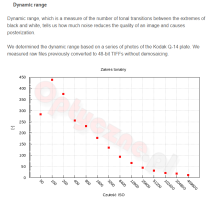

My google translate translates this section as 'tonal range', not 'dynamic range'.I really do appreciate P2P and the information they provide. Yet, the R1 data just looks odd. Base ISO 200?
Anyway, others test DR and here are the results from Optyczne
View attachment 221754
Looks a bit different than P2P. Peak performance at ISO 100 vs ISO 200, smooth curve vs indications of a second base ISO (dual gain sensor) at ISO 1600.
Where it is consistent, the R3 has slightly better DR than the R1.
View attachment 221755
For those wanting to convert the # of tones to stops, Stops = Log2 (# tones/y axis value)
Have you used the R5 II and A1....? The A1 does not hit its buffer as soon as the R5 II. For video the A1 has better IBIS and better dynamic range. I believe the R3 has more dynamic range than the R5 II also. The R5II is just not as powerful as the A1. So you just can't make claims that the R5II is better than the A1 without testing. Watching You Tube videos does not count.I will give you the Z 9 but the a1 does not do anything that the R5 II can't do.
The R5 II is in fact a lot better than the a1 when it comes to video.
For video specifically R5II actually has industry leading dynamic range - https://www.cined.com/camera-database/?camera=EOS-R5-Mark-II#camera-dynamic-ranage-stop2Have you used the R5 II and A1....? The A1 does not hit its buffer as soon as the R5 II. For video the A1 has better IBIS and better dynamic range. I believe the R3 has more dynamic range than the R5 II also. The R5II is just not as powerful as the A1. So you just can't make claims that the R5II is better than the A1 without testing. Watching You Tube videos does not count.
I also got 2 hours of record time on the A1 compared to 18 min on the R5II at 4K 120p. Big difference between the R5II and A1 overheating.
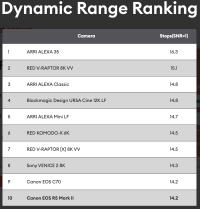
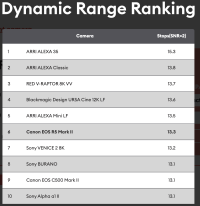
HaMy google translate translates this section as 'tonal range', not 'dynamic range'.
By all means, 'the number of tonal transitions' is not the dynamic range simply by definition of the dynamic range.
The dynamic range is simply not defined as a number of tones.Ha
Google vs Microsoft.
One translates it as Tonal Range (Google) and the other translates it as Dynamic Range (MS).
However, looking at their tests and what they did, even if there is a distinction, do you have a moment to elaborate on if you think there is a relevant difference to what we are discussing?
On P2P, you can find "engineering dynamic range" - EDR - which is closer to what you're probably thinking about. The "photographic dynamic range" -PDR - is a special normalised metric that's supposed to be used in comparisons of cameras with different sensor sizes and pixel counts. You can't use PDR outside of photonstophotos context.The Kodak Q-14 plate is used to measure dynamic range, it appears even by Imatest. This may not be 1:1 convertable with P2P, but few test results are. But I was more looking at the pattern/trend and commenting how it was different from P2P. Do you want to elaborate on why the test or perhaps the others on the same page shouldn't be compared to P2P's pDR?
I did and I can.So you just can't make claims that the R5II is better than the A1 without testing
Thanks for point it out. I think I have somewhat conflated Tonal Range and Dynamic Range so when Microsoft translated the text and called it Dynamic Range along with the Table that mostly fits the normal output, I went with it.The dynamic range is simply not defined as a number of tones.


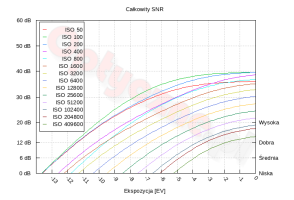
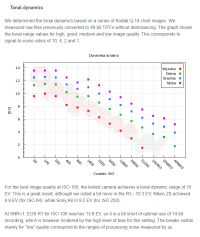
Optyczne.pl is a really great site. It's a pity they don't post in English, but I view it with Chrome and automatic translation so it's not a real problem.Thanks for point it out. I think I have somewhat conflated Tonal Range and Dynamic Range so when Microsoft translated the text and called it Dynamic Range along with the Table that mostly fits the normal output, I went with it.
I think Optyczne did look at their version of Dynamic range, just the section below what I pulled from and posted above. Trying to connect the dots:
P2P's definition of PDR:
View attachment 221849
Going to Imatest:
View attachment 221850
Optyczne's "Tonal Dynamics" section included the following:
View attachment 221851
Using Google Translate and based on their description in the text, Wysoka is "High" 10 S/N ratio, Dobra is "Good" and 4 S/N ratio, Srednia (mean) and Niska (Low) are S/N 2 and 1, respectively.
From the above, Optyczne generated the following (Google translated) summary:
View attachment 221852
So, they call this "Tonal Dynamics" but it seems to follow Imatests test method for dynamic range. The "Wysoka" and P2Ps definition (minus CoC) are both 20 dB. I am not saying exact results should mirror each other as anything in how this is set up/analyzed could vary a bit. I am still wondering about how P2P concluded ISO 100 is outside the normal range while Canon does call ISO 100 base ISO. But I am not sure anything here sheds light on that.
Optyczne also concluded that the dual gain was at ISO 800, not ISO 1600 shown by P2P.
This is the first time I have really looked at a Optyzne camera review. They came highly recommended by a photographer I respect and it is a sister site to Lenstip which I have used before. So, sorry for a few bumps, but generally, some interesting data.
